Using GEDI Waveforms for Improved TanDEM-X Forest Height Mapping: A Combined SINC + Legendre Approach
Abstract
:1. Introduction
2. Study Site and Data Preparation
2.1. Study Site
2.2. TanDEM-X Interferometric Data
2.3. Airborne Laser Scanning Data
2.4. GEDI Data
2.5. Forest Inventory Data
3. Methods
3.1. Radar Interferometry: Legendre Profiles
3.2. Mean ALS Profiles for Radar Coherence Height Estimation
3.3. Validation of TanDEM-X Canopy Height Estimates
4. Results
5. Discussion
6. Conclusions
Funding
Institutional Review Board Statement
Informed Consent Statement
Data Availability Statement
Acknowledgments
Conflicts of Interest
References
- Guliaev, R.; Cazcarra-Bes, V.; Pardini, M.; Papathanassiou, K. Forest Height Estimation by Means of TanDEM-X InSAR and Waveform Lidar Data. IEEE J. Sel. Top. Appl. Earth Obs. Remote Sens. 2021, 14, 3084–3094. [Google Scholar] [CrossRef]
- Qi, W.; Lee, S.-K.; Hancock, S.; Luttcke, S. Improved forest height estimation by fusion of simulated GEDI Lidar data and TanDEM-X InSAR data. Remote Sens. Environ. 2019, 221, 621–634. [Google Scholar] [CrossRef] [Green Version]
- Zhao, L.; Chen, E.; Li, Z.; Zhang, W.; Fan, Y. A New Approach for Forest Height Inversion Using X-Band Single-Pass InSAR Coherence Data. IEEE Trans. Geosci. Remote Sens. 2021, 1–18. [Google Scholar] [CrossRef]
- Cazcarra-Bes, V.; Albrecht, L.; Guliaev, R.; Choi, C.; Pardini, M.; Papathanassiou, K. Mapping global forest canopy height through integration of GEDI and Landsat data. In Proceedings of the Polinsar 2021, Online Event. 30 April 2021. Available online: https://next.brella.io/events/P2021oe/home (accessed on 30 November 2020).
- Pardini, M.; Cazcarra-Bes, V.; Papathanassiou, K. Forest Height and Structure Estimation by Means of InSAR Data—Using P-band profiles to estimate forest height. In Proceedings of the Polinsar 2021, Online Event. 29 April 2021. Available online: https://next.brella.io/events/P2021oe/home (accessed on 30 November 2020).
- Chen, H.; Cloude, S.R.; Goodenough, D.G. Forest Canopy Height Estimation Using Tandem-X Coherence Data. IEEE J. Sel. Top. Appl. Earth Obs. Remote Sens. 2016, 9, 3177–3188. [Google Scholar] [CrossRef]
- Chen, H.; Cloude, S.R.; Goodenough, D.G.; Hill, D.A.; Nesdoly, A. Radar forest height estimation in mountainous terrain using tandem-X coherence data. IEEE J. Sel. Top. Appl. Earth Obs. Remote Sens. 2018, 11, 3443–3452. [Google Scholar] [CrossRef]
- Cloude, S.R. Polarisation: Applications in Remote Sensing, 2nd ed.; Oxford University Press: Oxford, UK, 2009; ISBN 13: 978-0-19-956973-1. [Google Scholar] [CrossRef]
- Cloude, S.R. Polarization Coherence Tomography. Radio Sci. 2006, 41, RS4017. [Google Scholar] [CrossRef]
- Cloude, S.R. Dual Baseline Coherence Tomography. IEEE Geosci. Remote Sens. Lett. 2007, 4, 127–131. [Google Scholar] [CrossRef]
- Cloude, S.R.; Brolly, M.; Woodhouse, I. A study of forest vertical structure estimation using coherence tomography coupled to a macro-ecological scattering model. In Proceedings of the IEEE International Symposium on Geoscience and Remote Sensing 2009, Cape Town, South Africa, 12–17 July 2009. [Google Scholar] [CrossRef]
- White, J.C.; Chen, H.; Woods, M.E.; Low, B.; Nasonova, S. The Petawawa Research Forest: Establishment of a Remote Sensing Supersite. For. Chron. 2019, 95, 149–156. [Google Scholar] [CrossRef] [Green Version]
- Leckie, D.G. Advances in remote sensing technologies for forest surveys and management. Can. J. For. Res. 1990, 20, 464–483. [Google Scholar] [CrossRef]
- White, J.C.; Penner, M.; Woods, M. Assessing single photon LiDAR for operational implementation of an enhanced forest inventory in diverse mixedwood forests. For. Chron. 2021, 97, 78–96. [Google Scholar] [CrossRef]
- Kugler, F.; Schulze, D.; Hajnsek, I.; Pretzsch, H.; Papathanassiou, K. TanDEM-X Pol-InSAR Performance for Forest Height Estimation. IEEE Trans. Geosci. Remote Sens. 2019, 52, 6404–6422. [Google Scholar] [CrossRef]
- Dubayah, R.; Luthcke, S.; Blair, J.; Hofton, M.; Armston, J.; Tang, H. GEDI L1B Geolocated Waveform Data Global Footprint Level V001 [Data Set]; NASA EOSDIS Land Processes DAAC: Washington, DC, USA, 2020. [Google Scholar] [CrossRef]
- Krehbiel, C. Getting Started with GEDI L1B Version 2 Data in Python. Available online: https://lpdaac.usgs.gov/resources/e-learning/getting-started-gedi-l1b-version-2-data-python/ (accessed on 21 December 2020).
- Hancock, S.; Armston, J.; Hofton, M.; Sun, X.; Tang, H.; Duncanson, L.; Kellner, J.; Dubayah, R. The GEDI simulator: A large-footprint waveform lidar simulator for calibration and validation of spaceborne missions. Earth Space Sci. 2019, 6, 294–310. [Google Scholar] [CrossRef] [PubMed]
- Ontario Ministry of Natural Resources and Forestry. Forest Resources Inventory Technical Specifications. 2009. Available online: https://docs.ontario.ca/documents/2837/fim-tech-spec-forest-resources-inventory.pdf (accessed on 30 November 2020).
- Treuhaft, R.N.; Madsen, S.; Moghaddam, M.; van Zyl, J.J. Vegetation characteristics and underlying topography from interferometric data. Radio Sci. 1996, 31, 1449–1485. [Google Scholar] [CrossRef]
- Papathanassiou, K.P.; Cloude, S.R. Single baseline polarimetric SAR interferometry. IEEE Trans. Geosci. Remote Sens. 2001, 39, 2352–2363. [Google Scholar] [CrossRef] [Green Version]
- Cloude, S.R.; Papathanassiou, K.P. Three-stage inversion process for polarimetric SAR interferometry. IEE Proc. Radar Sonar Navig. 2003, 150, 125–134. [Google Scholar] [CrossRef] [Green Version]
- Chen, H.; Beaudoin, A.; Hill, D.A.; Cloude, S.R.; Skakun, R.S.; Marchand, M. Mapping Forest Height from TanDEM-X Interferometric Coherence Data in Northwest Territories. Canada. Can. J. Remote Sens. 2019, 45, 290–307. [Google Scholar] [CrossRef]
- Chen, H.; Hill, D.A.; White, J.C.; Cloude, S.R. Evaluating the Impacts of Using Different Digital Surface Models to Estimate Forest Height with TanDEM-X Interferometric Coherence Data. J. Radars 2020, 9, 386–398. [Google Scholar] [CrossRef]
- Hermosilla, T.; Wulder, M.A.; White, J.C.; Coops, N.C.; Hobart, G.W.; Campbell, L.B. Mass data processing of time series Landsat imagery: Pixels to data products for forest monitoring. Int. J. Digit. Earth 2016, 9, 1035–1054. [Google Scholar] [CrossRef] [Green Version]

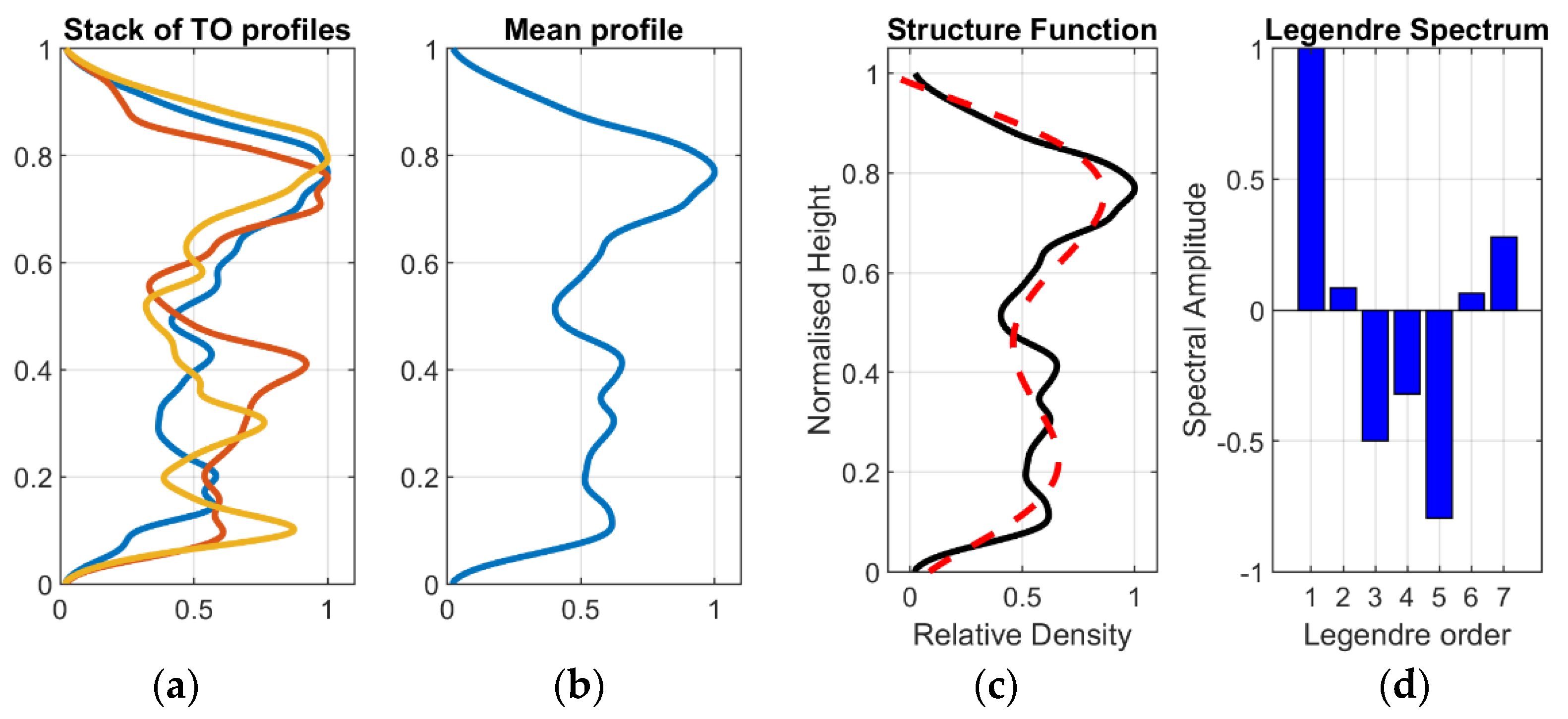
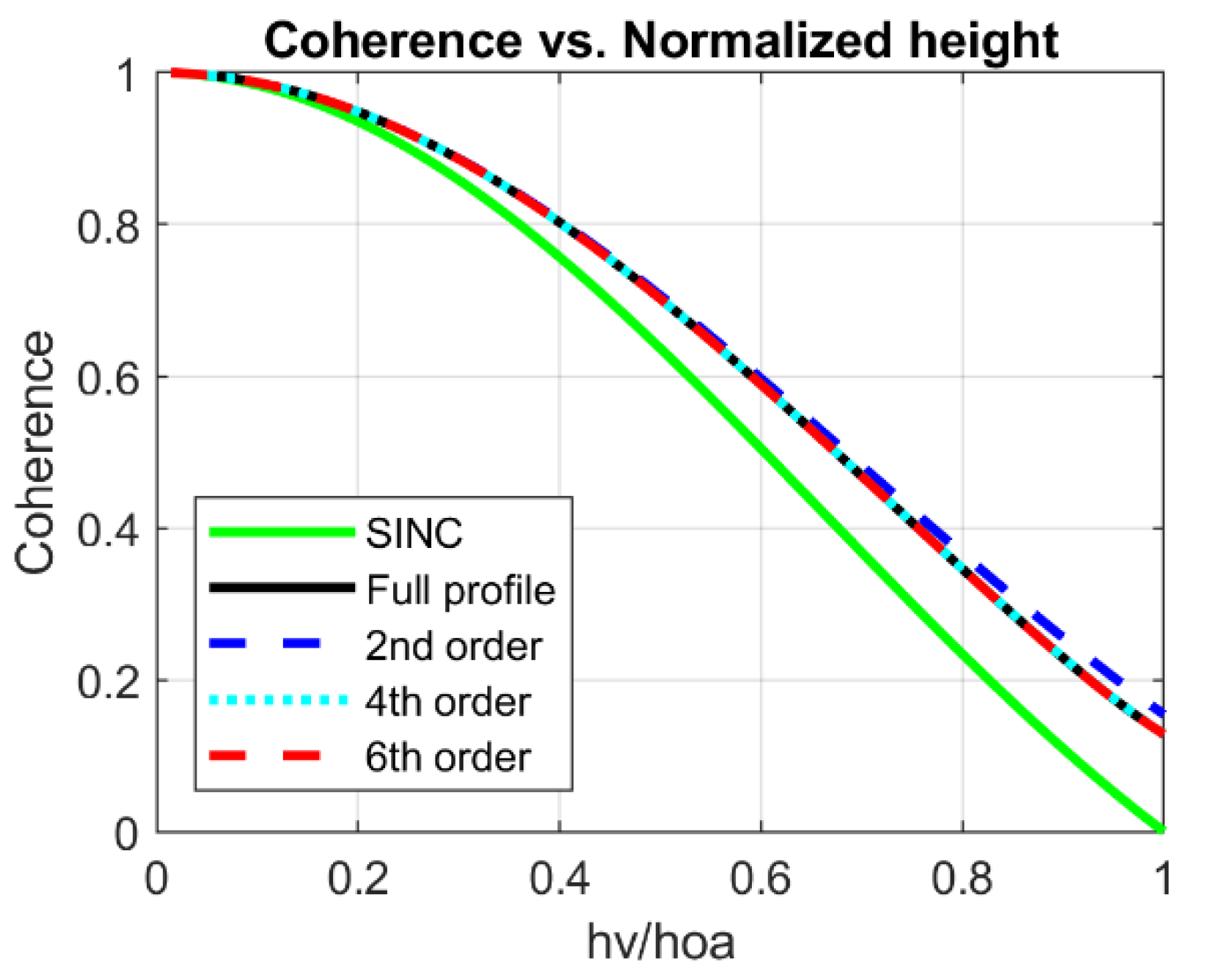
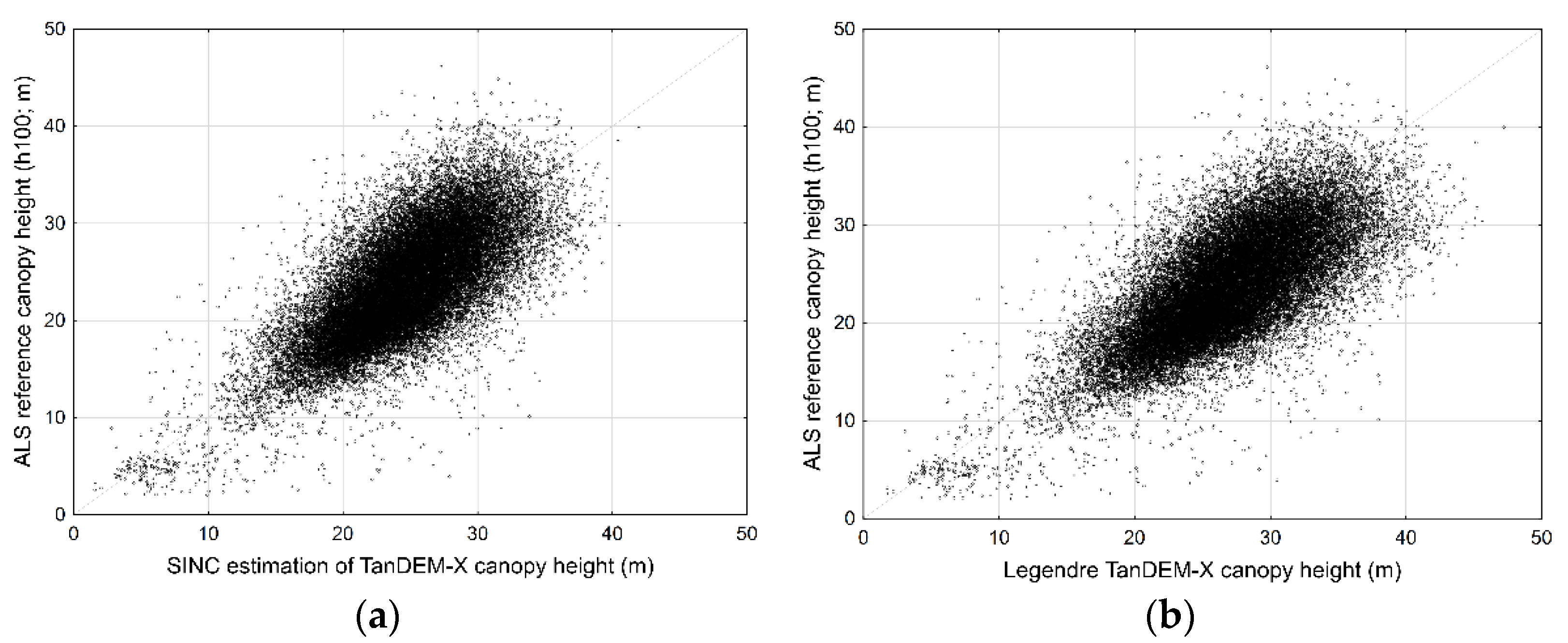
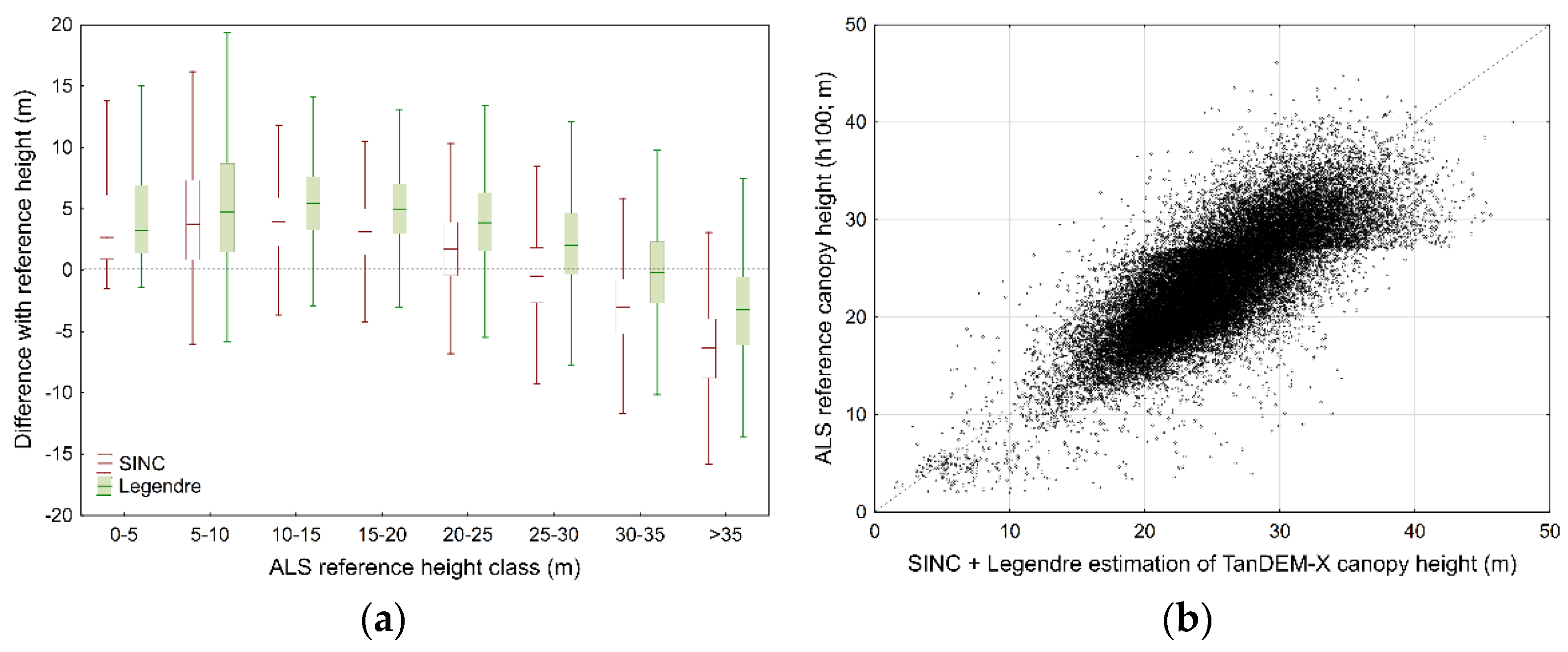
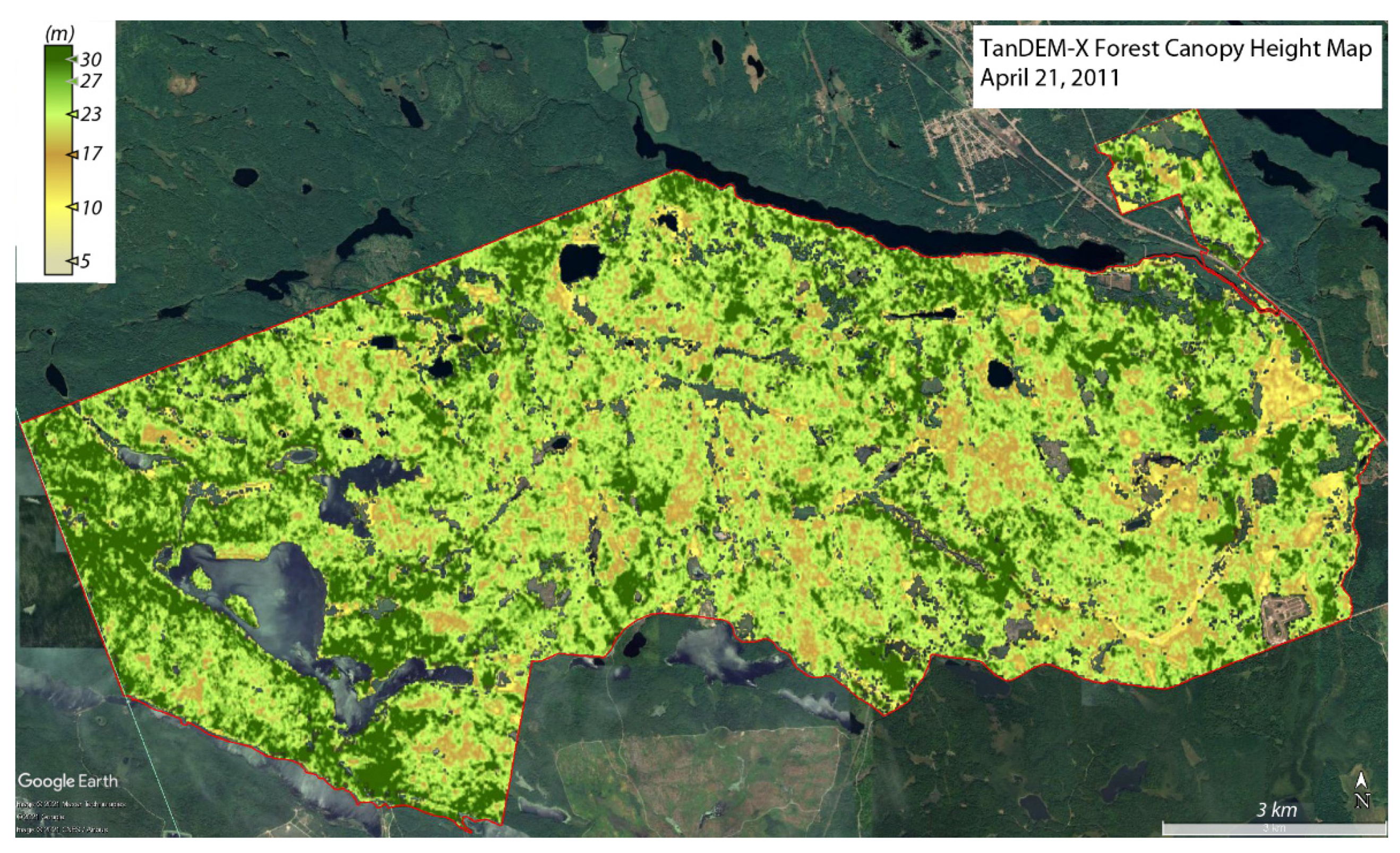

Publisher’s Note: MDPI stays neutral with regard to jurisdictional claims in published maps and institutional affiliations. |
© 2021 by the authors. Licensee MDPI, Basel, Switzerland. This article is an open access article distributed under the terms and conditions of the Creative Commons Attribution (CC BY) license (https://creativecommons.org/licenses/by/4.0/).
Share and Cite
Chen, H.; Cloude, S.R.; White, J.C. Using GEDI Waveforms for Improved TanDEM-X Forest Height Mapping: A Combined SINC + Legendre Approach. Remote Sens. 2021, 13, 2882. https://doi.org/10.3390/rs13152882
Chen H, Cloude SR, White JC. Using GEDI Waveforms for Improved TanDEM-X Forest Height Mapping: A Combined SINC + Legendre Approach. Remote Sensing. 2021; 13(15):2882. https://doi.org/10.3390/rs13152882
Chicago/Turabian StyleChen, Hao, Shane R. Cloude, and Joanne C. White. 2021. "Using GEDI Waveforms for Improved TanDEM-X Forest Height Mapping: A Combined SINC + Legendre Approach" Remote Sensing 13, no. 15: 2882. https://doi.org/10.3390/rs13152882
APA StyleChen, H., Cloude, S. R., & White, J. C. (2021). Using GEDI Waveforms for Improved TanDEM-X Forest Height Mapping: A Combined SINC + Legendre Approach. Remote Sensing, 13(15), 2882. https://doi.org/10.3390/rs13152882







